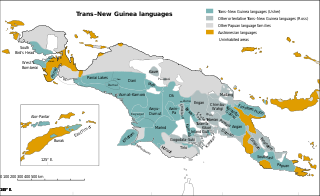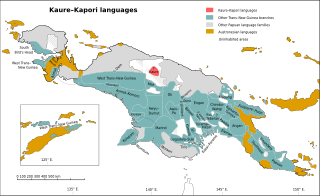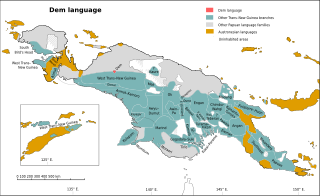
Trans–New Guinea (TNG) is an extensive family of Papuan languages spoken on the island of New Guinea and neighboring islands, a region corresponding to the country Papua New Guinea as well as parts of Indonesia.

The East Geelvink Bay or East Cenderawasih languages are a language family of a dozen Papuan languages along the eastern coast of Geelvink Bay in Indonesian Papua, which is also known as Sarera Bay or Cenderawasih.
The Border or Upper Tami languages are an independent family of Papuan languages in Malcolm Ross's version of the Trans–New Guinea proposal.
The Nimboran languages are a small family of Papuan languages, spoken in the Grime River and Nawa River watershed in Jayapura Regency, that had been part of Stephen Wurm's Trans–New Guinea proposal. However, when proto-Nimboran pronouns are reconstructed (*genam "I" and kom or komot "thou"), they have little resemblance to the proto-TNG pronouns *na and *ga. Usher places them in a North Papuan stock that resembles Cowan's proposal.
Usku, or Afra, is a nearly extinct and poorly documented Papuan language spoken by 20 or more people, mostly adults, in Usku village, Senggi District, Keerom Regency, Papua, Indonesia.
Numbami is an Austronesian language spoken by about 200 people with ties to a single village in Morobe Province, Papua New Guinea. It is spoken in Siboma village, Paiawa ward, Morobe Rural LLG.
Kâte is a Papuan language spoken by about 6,000 people in the Finschhafen District of Morobe Province, Papua New Guinea. It is part of the Finisterre–Huon branch of the Trans–New Guinea language family. It was adopted for teaching and mission work among speakers of Papuan languages by the Evangelical Lutheran Church of Papua New Guinea in the early 1900s and at one time had as many as 80,000 second-language speakers.
The Pauwasi languages are a likely family of Papuan languages, mostly in Indonesia. The subfamilies are at best only distantly related. The best described Pauwasi language is Karkar, across the border in Papua New Guinea. They are spoken around the headwaters of the Pauwasi River in the Indonesian-PNG border region.

The Kaure–Kosare or Nawa River languages are a small family spoken along the Nawa River in West Papua, near the northern border with Papua New Guinea. The languages are Kaure and Kosare.
Papuan Malay or Irian Malay is a Malay-based creole language spoken in the Indonesian part of New Guinea. It emerged as a contact language among tribes in Indonesian New Guinea for trading and daily communication. Nowadays, it has a growing number of native speakers. More recently, the vernacular of Indonesian Papuans has been influenced by Standard Indonesian, the national standard dialect. It is spoken in Indonesian New Guinea alongside 274 other languages and functions as a lingua franca.

Dem is a divergent Papuan language of West New Guinea. Although Palmer (2018) leaves it unclassified, it was tentatively included in the Trans–New Guinea family in the classification of Malcolm Ross (2005), and Timothy Usher ties it most closely to Amung.

Mor is a nearly extinct Trans–New Guinea language of Indonesia. It is spoken along the Budidi River and the Bomberai River on the Bomberai Peninsula.
Molof is a poorly documented Papuan language spoken by about 200 people in Molof village, Senggi District, Keerom Regency.
Tofanma or Tofamna is a poorly documented Papuan language of Indonesia. Wurm (1975) placed it as an independent branch of Trans–New Guinea, but Ross (2005) could not find enough evidence to classify it. It appears to be related to Namla, a neighboring language.
Murkim is a Papuan language of Western New Guinea, near its relatives Lepki and Kembra. Though spoken by fewer than 300 people, it is being learned by children. It is spoken in Murkim District, Pegunungan Bintang Regency, Papua Province, Indonesia.
Kayagar is a Papuan language spoken in South Papua. Wiyagar is spoken in Sigare Village, Kaitok Village and Yame Village in Assue District, Mappi Regency, While Kaigar is spoken in Amagais Village, Der Koumur District, Asmat Regency.
Yetfa and Biksi are dialects of a language spoken in Jetfa District, Pegunungan Bintang Regency, Highland Papua, Indonesia, and across the border in Papua New Guinea. It is a trade language spoken in Western New Guinea up to the PNG border.

Wolani (Wodani) is a Papuan language spoken by about 5,000 people in the Paniai lakes region of the Indonesian province of Central Papua. It is related to the Moni, Ekari, Auye, and Dao languages and may be related to the Dani languages. Documentation is quite limited.
Kimki (Aipki) or Sukubatom (Sukubatong) is a South Pauwasi language of Batom District, Pegunungan Bintang Regency, Papua, Indonesia. Foley classifies Kimki as a language isolate, although he notes some similarities with Murkim. Usher demonstrates a connection to the other South Pauwasi languages.

Lake Sentani is a tropical, shallow, and at low-altitude open lake located at the northeast extremity of the Jayapura Regency in the Indonesian province of Papua, about 20 kilometres (12 mi) from the provincial capital, Jayapura City. It is located just to the south of the town of Sentani.







